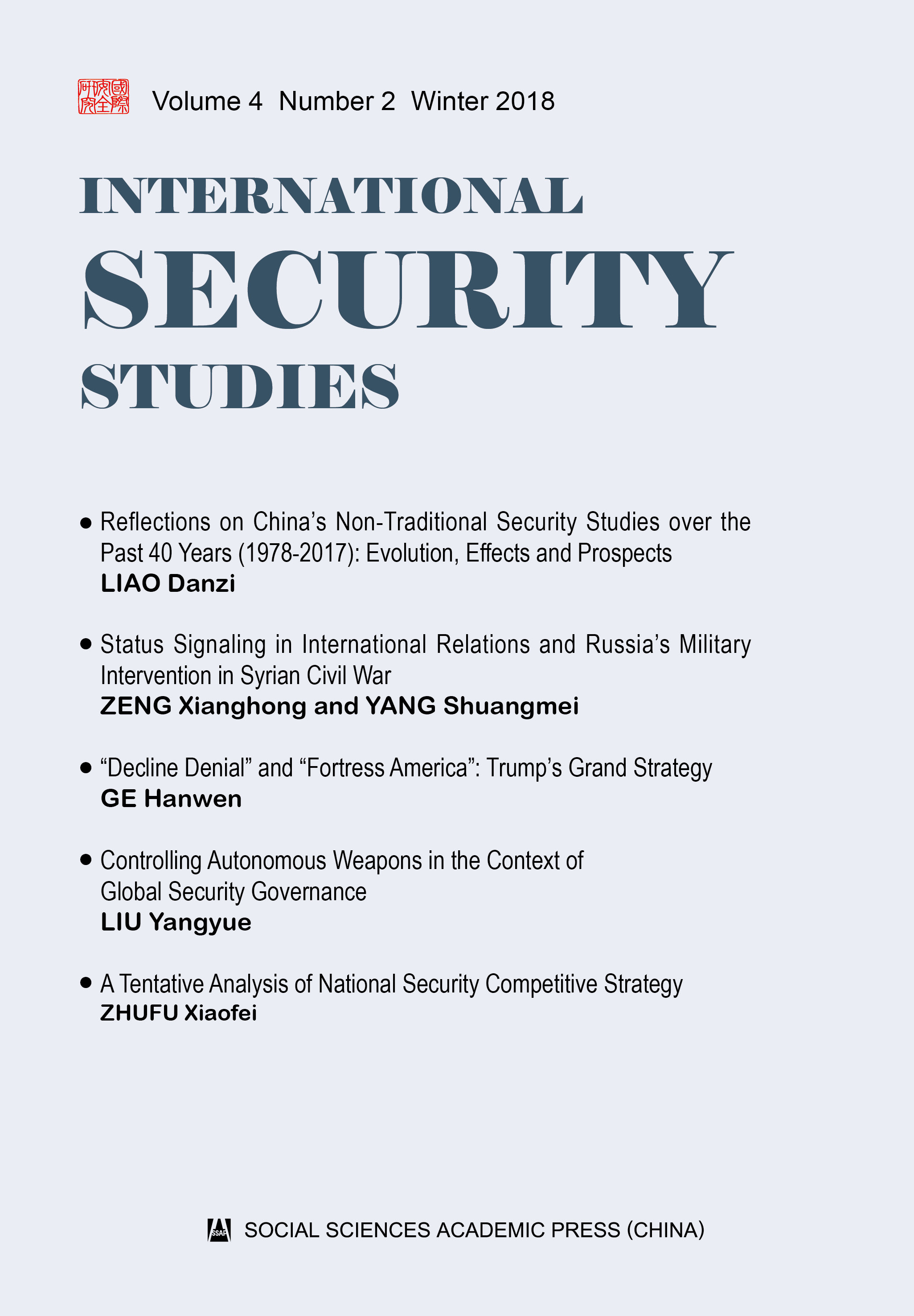International Security Studies(Volume 4, Number 2, Winter 2018 )图书
International Security Studies (Volume 4, Number 2, Winter 2018 )
[内容简介] 本书是由国际关系学院主办的《国际安全研究》的英文半年集刊,主题是国际安全理论研究,内容涉及不干涉内政学说、世界体系的发展、历史视角中的三次世界大战、质性和平的条件比较(当代东亚与战后西欧)、当代国际安全的文化价值基础、互联网对国际政治影响机理、中国周边安全环境指标体系及其评估、联合阵线与美国军事干涉等问题的研究。
相关信息
版权页
Reflections on China’s Non-Traditional Security Studies over the Past 40 Years (1978-2017):Evolution, Effects and Prospects
1 Research Methodology and a General Analysis of the Literature
1.1 Research Methods and Previous Results
1.2 An Overall Bibliometric Analysis
1.2.1 The Distribution and Trend of the Literature
1.2.2 Source Journals and High-Frequency Keywords
1.2.3 An Analysis of the Discipline,Funds and Level of Research
1.2.4 Landmark “Events”
1.3 The Path of Diachronic Evolution
2 The Academic Characteristics of NTSS in China
2.1 Genesis and the Path of Evolution
2.2 Rich Diversity in Contents
2.2.1 Clearer Key Definitions
2.2.2 Consensus on Basic Problems
2.2.3 Innovations in Topic Dimensions
2.2.4 Contentions over Viewpoints
2.2.5 Progressive Interdisciplinary Attempts
2.2.6 Louder Voice from the “China School” in NTSS
2.3 Distinct Categories/Genres
2.4- Diverse Driving Factors
2.5 Institutionalization of NTSS
3 Academic Significance of NTSS and Its Influence on China’s Policies
3.1 Academic Significance
3.2 Influence on Policies
4 Problems in NTSS in China and a Better Scenario
4.1 Major Problems
4.2 A Future Scenario
5 Conclusion
Status Signaling in International Relations and Russia’s Military Intervention in Syrian Civil War
1 Proposal
2 The Significance of Status Signaling in International Relations and Its Studies
3 Status Signaling and Choice of Strategies
3.1 Selection of Status Signal Types
3.2 Selecting Signaling Strategies and Its Influencing Factors
4 Status Signaling: The goal of Russia’s Military Intervention in Syria
5 Target Audiences and Russia’s Strategy Choice for the Intervention in Syria
6 Conclusion
“Decline Denial” and “Fortress America”: Trump’s Grand Strategy
1 The Theory of Grand Strategy and the US National Security Strategy
2 “America First”: Trump’s Grand Strategy
3 “Decline Denial” and “Fortress America”: The Logic and Flaws in Trump’s Strategy
Controlling Autonomous Weapons in the Context of Global Security Governance
1 Motions on Arms Control of Autonomous Weapons in the Context of Global Security Governance
2 On the Concept Level: Vague Objects Targeted by Arms Control of Autonomous Weapons
3 On the Value Level: Major Driving Forces for Arms Control of Autonomous Weapons
4 On the Level of Security: Arms Control of Autonomous Weapons is Subject to Expected Returns.
5 The Gloomy Prospect of Arms Control over Autonomous Weapons
6 Conclusion
A Tentative Analysis of National Security Competitive Strategy
1 Approaches to Constructing Competitive Strategies and Their Implications
1.1 Attainment of Competitive Advantages as a Key Dominant in Prevailing in the Global Security Arena
1.2 Dependence of the Winning of Competitive Advantages of National Security on the Formulation of Competitive Strategies to be Employed
1.2.1 Gaining an Insight into Current Major Trends
1.2.2 Understanding International Patterns
1.2.3 Analysing Competitors
1.2.4 Using SWOT Analysis Method to Formulate Competitive Strategies for National Security
2 Major Principles in Carrying out Competitive Strategies for National Security
2.1 Maintaining and Shaping Unique Values
2.2 Balancing Costs and Benefits
2.3 Action in Inaction and Inaction in Action
2.4 Combining Competition & Confrontation and Mutually Beneficial Cooperation
2.5 Combining Homogenous and Heterogeneous Competitions
3 Choosing Appropriate Strategies to Gain Competitive Advantages Concerning National Security
3.1 Strengthening Economic Power as a Priority
3.2 Minimizing Total Cost
3.3 Differentiation
3.3.1 Emphasis on Asymmetry in the Leadership Strategic Thinking
3.3.2 Emphasis on Peak-shifting Measures in Policy Formulation and Implementation
3.3.3 Emphasis on Provision of Services Differentiated from Those Offered by Hegemonic States in Handling International Affairs
3.4 Concentration Strategy
3.4.1 Target Concentration Approach
3.4.2 Regional or Directional Concentration
3.4.3 Capacity Concentration
3.5 Corner Overtaking
3.5.1 The Fundamental Route Path to Corner Overtaking is Institutional and Technological Innovation
3.5.2 Pressure Creates an Incentive to Innovate
3.5.3 Innovation is Attributable to Penetrating Insight and Envisioned Planning
4 Preliminary Strategic Approach to China’s Competitiveness of National Security under New Conditions
5 Conclusion
Resource Security and Global Governance: An Analysis of the European Union’s Security Strategy for Mineral Resources
1 Multi-dimensional Power and Mineral Resource Security
2 The Endowment Limit, the Declining Hegemony and the Limited Independence of Resource of the EU
2.1 The Dilemma of EU’s Mineral Resource
2.2 The Limited Independence of Resource of the EU
3 The Global Governance of Mineral Resources and the EU’s Resource Security
3.1 Liberal Trade Regulations of Mineral Resources
3.2 The Price-Fixing Mechanism of Mineral Resources
3.3 The Industrial Standard of Mineral Resources
3.4 The Investigating Network of Geological Information
4 Conclusion
US Military Climate Change Risks Management and Its Behavioral Logic under the Trump Administration
1 Scientific Basis for and Background to US Military Policy hoices
1.1 Climate Change Threatens the US National Security
1.2 Basic Approaches to Climate Change-induced Threats
1.3 The Obama Administration’s Policy Option
2 The US Military’s Fundamental Doctrine and Their Characteristics in the Early Days of the Trump Administration
2.1 The US Military’s Persistence with Views on Climate-induced Risk Management and Control
2.2 Changes in the US Military’s Policy Priorities
3 Operational Logic behind the US Military’s Management of Climate Risks
3.1 Financial Incentives of the US Federal Government and the US Military
3.2 Limitations of the Trump Administration’s the Mainstream Cognition
3.3 Partisan Differences in the US Congress Resolved to Boost Military Action
4 Conclusion
Notice to Contributors




